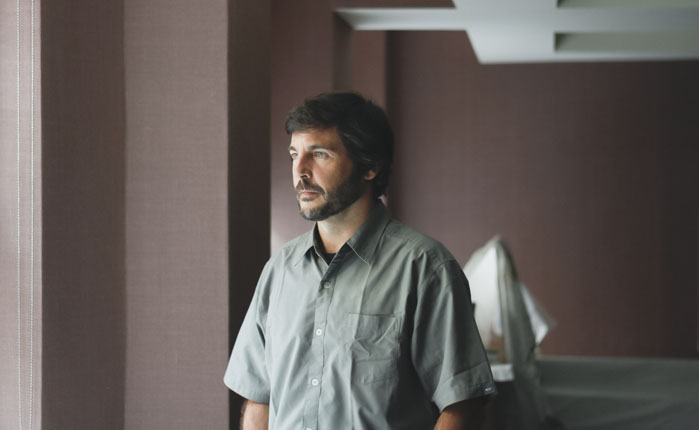One Minute With Diego Quemada-Diez - Director of The Golden Dream
Gavin Mecaniques | Thursday 10 July, 2014 19:33

The Golden Dream is the debut feature from Diego Quemada-Diez, a documentary maker and former cinematographer for Ken Loach. A story of three teen immigrants on a quest from South America to the US, it won the Un Certain Talent Award at Cannes.
What made you become a filmmaker?
I always wanted to be a poet, and I wrote poetry and made short films and I tried to put some poetry into that. José Val del Omar from Granada is an influence—he talks about the meta-mystic of the cinema in a manifesto from the 60’s that I like very much. He says that one should only manipulate the audience if there is a great poetic intention. Forough Farrokhzad is another who made a film about a leper colony called House of Black, it’s pretty intense. I like a lot of Persian, Spanish and South American poets. I think a film should have a poetic layer, a narrative layer and a political layer, so you think why are you making a film, what are you wanting to say. I see filmmaking as a responsibility in a way, like if we trivialise, for example, the killing of somebody—nothing against Tarantino, but when I saw his last film I found myself laughing after you kill 400 people. So dramatising the killing of a human being makes more sense to me because trivialising just helps the military industrial complex and the propaganda of violence.
What was the film’s genesis?
Over 10 years ago, I was inspired by reading about people who immigrate, and I took a plane and ended up in Mazatlan in Cineloa and started making a documentary. One night I met a taxi driver who I made friends with and eventually ending up living with his family. They lived by the railroad tracks, and every day a train would arrive with hundreds of immigrants and I started talking with them, hearing their stories, testimonies and dramas, with the intention of telling their stories. I struggled a lot between wanting to make a film or a documentary and making a living, as a camera operator. Slowly I got clearer about how to solve that dilemma, of how to take from reality the truth of the screenplay. It’s a very difficult method this doc-fiction thing.
Is it fair to say the characters internalise what they’re hoping to escape from?
I took a lot of testimonies from migrants and I found that behind the migration problem there is a post-colonial issue, of two cultures that are clashing, trying to control the other, of a fight for territory. So to articulate that, I found that I could clash an Indian and a mixed-raced character who believed in the western ideal. I thought what if the story becomes the opposition of these two ways of looking at the world, which are totally different from each other, and the westerner transforms his personality and the way he looks at things. I was interested in looking at a sense of brotherhood beyond racism and nationalities. Because they are all artificial creations, it’s not a utopian or idealistic thing to say this, we are all one planet that’s the truth, everything else is a creation we have made to separate ourselves from others. I travel a lot and everywhere I go I encounter this: Korea, China, Japan, Russia.
Ken always told me, “Ok you may have an idea, but the issue is how to articulate it, that’s the most difficult thing,” and I was lucky because I found this idea of the clash, so I thought, “Why don’t I make it about cowboys and indians?” That’s also behind the clash, and enables the story to become a kids film and an adventure film and gives it more layers.
You used amateur actors?
I think the idea of working with non-actors is mostly because I find them fascinating, and in some of the documentaries I made, I found that the truth from a real person is so powerful, it’s nothing that can you find from an actor. I mean an actor has incredible talent, but for this particular film I wanted to give voice to real people, and I had been inspired by this film Rodrigo D , a 1990 film by Víctor Gaviria with non-actors. We saw over 6,000 kids in these communities and at times it was very dangerous, but I thought it was very important. And in the writing process the character becomes a mixture of what you wrote, from real testimonies and your imagination and details you pick up from different places, and then you find the actor and he or she brings so much, though not everything. You take a combination of reality from fiction and vice versa, and you blend them and you hope it’s going to combine properly.
The Golden Dream is beautifully constructed. How did you balance both dialogue and visuals?
Well, film is mostly a visual medium. I always try to watch silent movies and Aki Kaurismaki, he uses very little dialogue, I really hate when a film uses too much dialogue and is overly literal. Trying to create subtext is the most difficult and important thing, as in how you convey an idea without actually hitting the audience with it. I wanted to make a poetic film, so I had to think, what are the tools of poetry in film: visual metaphors, rhymes, elements and images repeating in differing ways. Haneke’s The 7th Continent and also the film Happy Together come to mind, getting you in an abstract mode where you’re trying to understand more conceptual ideas instead of knowing exactly everything. Then I had oppositions: human and machine; birds and cages; cowboys and Indians. I was always thinking about this, trying to work from visual opposites, that you can somehow find and integrate and play with. At one point we found a horse with a cowboy and we said let’s get him in.
Ken taught me that the director is responsible for telling the story visually, for putting the camera and the lens where he thinks. So obviously you collaborate with the cinematographer but one needs to be very clear of how to tell the story visually. I was basically shooting the entire scene with different lenses, but with a sense of becoming a witness of a real event, not really making a movie. You try to film most of the film in continuity, and the actors don’t know the script because you give it to them as you go, start on page 1 and end on the last page, and the actors have a real experience and you really don’t have to do much, you have to focus and the most difficult part is the casting. You put them in situations that feel real, you try to hide the film crew as much as possible, so they forget there is a camera is there, when you’re work-shopping you teach them to lock their eyes on the other actor(s) and at some point everything else becomes invisible and they don’t even care that it’s there. During the film they discover the story as it moves and they discover the reactions within themselves. You focus on creating the context, that provokes their reaction and don’t try to control how they do it, because you want them to be themselves. You rewrite as you go because you want them to be how they would speak to their own people. And all you do is film it as if you were an observer of the event.
The Golden Dream is currently on release in London.
Image of Diego Quemada-Diez Copyright Gavin Mecaniques.
Snipe Highlights
Some popular articles from past years
- Nice map of London's fruit trees shows you where to pick free food
- Only 16 commuters touch in to Emirates Air Line, figures reveal
- A unique collection of photos of Edwardian Londoners
- The best church names in London, and where they come from
- London has chosen its mayor, but why can’t it choose its own media?
- Number of people using Thames cable car plunges
- Nice Interactive timeline lets you follow Londoners' historic fight against racism
- Random Interview: Eileen Conn, co-ordinator of Peckham Vision
- The five spookiest abandoned London hospitals
- Peter Bayley has worked for 50 years as a cinema projectionist in East Finchley
© 2009-2025 Snipe London.
